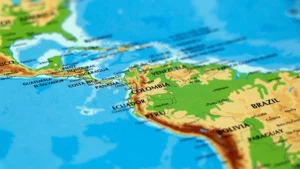The Boston Consulting Group (BCG) predicts global trade will grow at a 2.8% annual rate until 2032.
This forecast sits just below the global GDP’s expected 3.1% annual increase.
Despite a modest growth projection of 0.8% for 2023, the World Trade Organization (WTO) anticipates a 3.3% surge in global trade by 2024.
International trade is undergoing significant shifts as supply chains rebalance and countries enhance regional trade connections.
These changes promise lasting alterations in the global goods movement.
In 2024, global trade revival may boost exports from Latin America and the Caribbean, but diversification of regional exports remains challenging.

The World Bank predicts a slow, steady recovery for Latin America, with economic growth forecast at 2.3% for 2024 and 2.5% for 2025.
This growth is partly due to expected improvements in global and intra-regional trade.
Geopolitical tensions disrupt global supply chains, highlighting reliance on raw materials and manufacturing amid volatility.
Such economic shifts, coupled with geopolitical dynamics, emphasize the importance of national economic security, job creation, and green energy.
This focus is expected to reinforce regional trade blocs in North America, the European Union, and ASEAN.
Latin America stands to gain from geopolitical fragmentation by seizing new market opportunities.
The trade dynamics between the United States and Mexico, for instance, illustrate this point.
Mexico recently surpassed China as the primary source of US imports, a shift attributed to the nearshoring trend and regional trade agreements like the USMCA.
Trade between the United States and Mexico is expected to increase by $300 billion over the next decade.
Despite the West’s reduced trade with China, Latin America cannot afford to ignore the Asian giant.
China’s role as a leading global exporter and its increased share of global imports underscore its importance.
Bilateral trade between China and Latin America has seen a dramatic increase, with China overtaking the European Union as the region’s second-largest trading partner.
In addition, even as China faces economic slowdowns, its impact on other regions remains significant.
ASEAN and India to gain from reduced Chinese manufacturing reliance, accessing new markets, and cutting global supply chain risks.
Trade between China and these nations is projected to reach $616 billion in the next decade, indicating a diversification of global trade routes and partners.
In short, Latin America can expand economically by leveraging geopolitical shifts and regional partnerships to enhance trade and investment opportunities.

